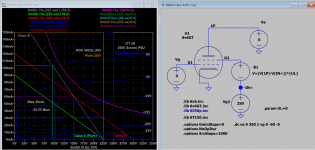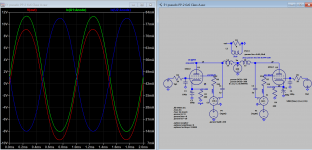kodabmx,
Push Pull amplifier
Historically, the old Class B definition was that neither tube conducts quiescent current.
Then, when signal was applied, the tubes alternately conduct (according to the polarity of the signal).
The idea was to have each tube conduct for 180 degrees, the first tube from 0 to 90 to 0, and the second from 0 to -90 to 0.
Of course, for a practical class B amplifier, they often were designed to conduct a very small amount of quiescent current in each tube.
But that is not strictly Class B by the old definition.
With a very small amount of quiescent current in each tube, it actually is Class AB (well really a very poor Class AB).
Push Pull amplifier
Historically, the old Class B definition was that neither tube conducts quiescent current.
Then, when signal was applied, the tubes alternately conduct (according to the polarity of the signal).
The idea was to have each tube conduct for 180 degrees, the first tube from 0 to 90 to 0, and the second from 0 to -90 to 0.
Of course, for a practical class B amplifier, they often were designed to conduct a very small amount of quiescent current in each tube.
But that is not strictly Class B by the old definition.
With a very small amount of quiescent current in each tube, it actually is Class AB (well really a very poor Class AB).
Last edited:
Is there anyone disagree with definition of pure Class A pp description here?
Is the Vox AC-30 Really Class A?
Is the Vox AC-30 Really Class A?

